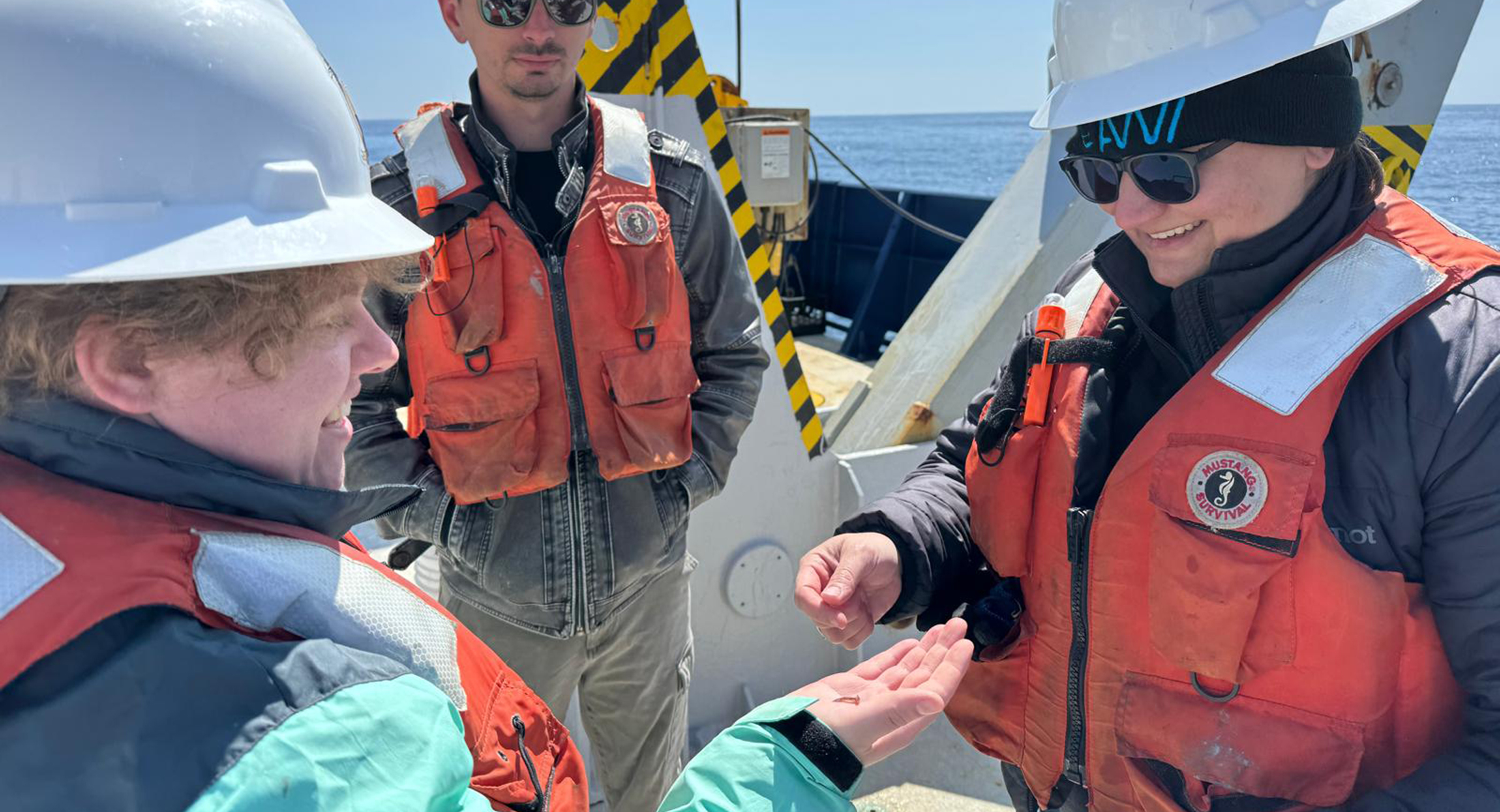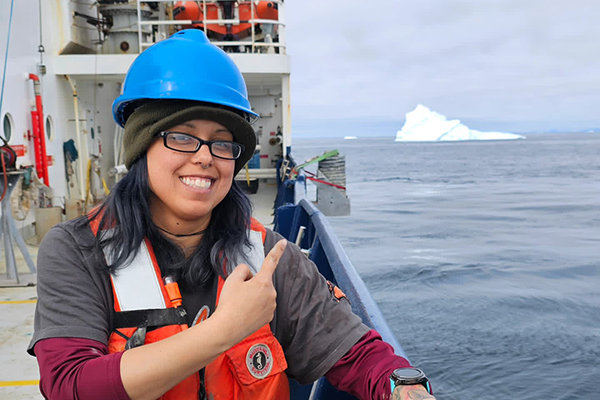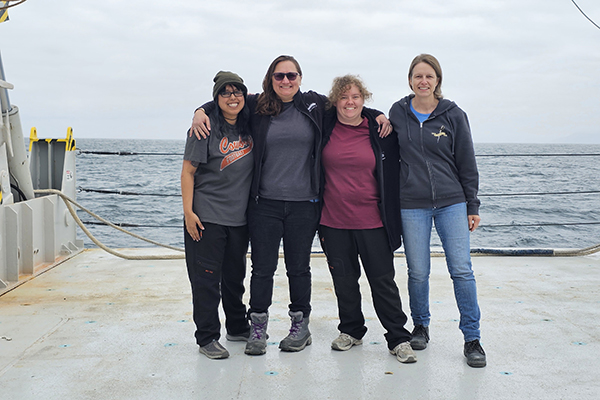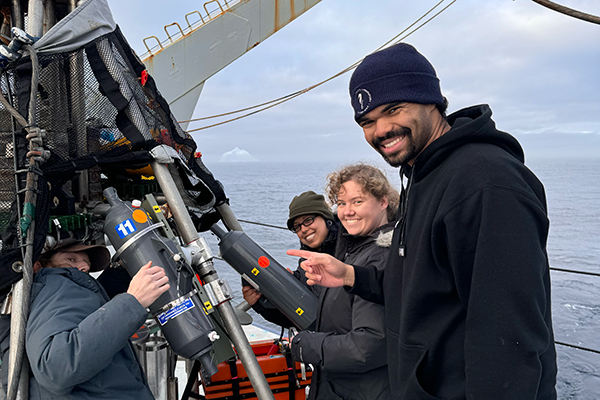
Geology faculty, students set sail on NSF-funded research expedition to Labrador Sea
Friday, August 15, 2025
Media Contact: Elizabeth Gosney | CAS Marketing and Communications Manager | 405-744-7497 | egosney@okstate.edu
Two faculty members and two graduate students from Oklahoma State University’s Boone Pickens School of Geology recently returned from a 5-week international research expedition aboard the R/V Roger Revelle, a research vessel operated by Scripps Institution of Oceanography.
From June to July, the OSU team of Dr. Ashley Burkett, Dr. Natascha Riedinger, Amanda Harding and Monica Hinson joined 29 scientists from 12 institutions to collect sediment and seawater samples across the Labrador Sea. The expedition was part of a National Science Foundation-funded project, “A Porewater Perspective on Benthic Sources of Neodymium to the North Atlantic” and focused on how seawater chemistry is both preserved in and influenced by seafloor sediments.
“The results of this study helped uncover how trace elements like iron and rare earth elements travel between seawater and sediments,” Burkett said. “This is an important process that shapes ocean life, regulates global carbon cycles and provides vital clues for reconstructing Earth’s climate history.”
Throughout the expedition, scientific operations ran 24 hours a day, with research teams working in rotating shifts to collect and process samples. Over the course of just five weeks, the team collected:
- 55 multicores — used to retrieve surface sediments from the seafloor to look at modern samples.
- 12 gravity cores — longer sediment samples reaching deeper below the surface to allow researchers to look further back in time.
- 28 CTD casts — instruments that captured water from different depths and measured ocean conditions such as temperature, salinity and oxygen.
- McLane pumps — devices that filtered particles from the water column at different depths.
Graduate and undergraduate students played a leading role in deploying instruments and processing these samples during the expedition.
“This kind of expedition is transformative for early-career scientists,” Burkett said. “They didn’t just learn about oceanography in a classroom, they lived it — from deploying coring devices to analyzing data onboard a world-class research vessel.”
Many of the student participants, including OSU’s Harding and Hinson, will go on to conduct graduate theses on the materials recovered in this expedition.
“This cruise was a great experience and I am excited to look at these samples to investigate questions that I came up with during my time at sea,” Harding said. “I loved being a graduate student in the Boone Pickens School of Geology and being able to work as a teaching assistant, so I decided to stay for my Ph.D. and continue working on ideas that I had been playing with during my master’s research.”



In addition to gaining valuable field experience in marine geochemistry, sediment biogeochemistry and paleoceanography, Harding and Hinson saw firsthand the attributes that make up successful scientists.
“When you are at sea, there are no days off, so it takes a unique passion for science to show up and do your best every day,” Hinson said. “As a scientist on this expedition, I ended this cruise with an incredible appreciation for the sample collection process and the teamwork required to make such a project like this happen.”
Burkett and Riedinger, who themselves have had varied field experiences throughout their careers, were not part of the expedition’s original funded project team. However, they were invited to join because of their specialized expertise: Burkett in benthic foraminifera and seafloor sampling techniques and Riedinger for her vast seagoing experience and work on sedimentary redox processes and element cycling.
Burkett explained that researchers venture to the North Atlantic Ocean, particularly the Labrador Sea, because of the central role it plays in regulating Earth’s climate through a system known as the Atlantic Meridional Overturning Circulation.
“As warm surface waters move north and cool, they sink and form deep waters that help drive global ocean currents,” Burkett said. “These deep waters not only transport heat — they also carry oxygen, nutrients and carbon, making this region vital to both the climate system and marine life.”
Burkett explained further that the project focuses on neodymium isotopes, one of the most widely used tracers in paleoceanography, and rare earth elements to study the movement and transformation of chemical signatures that track deep ocean circulation over time. By measuring how neodymium moves between sediments and seawater, researchers aim to refine how scientists interpret ancient ocean currents and climate change signals recorded in marine sediments.
“Scientists have long suspected that seafloor sediments on the continental shelf supply iron to the Labrador Sea — an important nutrient that supports the growth of tiny ocean plants called phytoplankton,” Burkett said. “These phytoplankton form the base of the ocean food web and help absorb carbon dioxide from the atmosphere.
“Until now, however, no one had directly measured how much iron is released from the seafloor in this region or what controls that process. During the expedition, our team studied how iron moves from the sediments into the water above and investigated the natural conditions — like oxygen levels, temperature and currents — that affect this movement.”
The work of Burkett, Riedinger, Harding, Hinson and the rest of the expedition team is helping scientists better understand how the ocean naturally supplies nutrients — a crucial piece in predicting how marine ecosystems and the global carbon cycle may respond to climate change.
For more information about this research, check out the seals2025.com blog. To request a classroom visit or outreach presentation, contact Dr. Ashley Burkett at ashley.burkett@okstate.edu.
